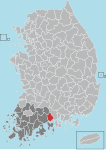Jungma-dong
This is your travel guide for Jungma-dong in Gwangyang, Jeollanam-do, Korea
1 : Visit Gwangyang Maehwa Village [2 hrs]
Explore the picturesque Maehwa Village known for its beautiful plum blossoms, especially stunning during spring. Wander through the narrow lanes lined with traditional Korean houses, enjoy the fragrant plum blossoms in full bloom, and capture the perfect Instagram-worthy shots. Don’t miss trying local plum delicacies like plum tea, plum makgeolli (rice wine), and plum ice cream.
2 : Experience Gwangyang Bamboo Forest [3 hrs]
Immerse yourself in the serene atmosphere of the Gwangyang Bamboo Forest, the largest bamboo forest in South Korea. Take a leisurely stroll along the well-maintained paths amidst tall bamboo groves, listen to the calming rustle of bamboo leaves, and unwind in nature’s tranquility. Discover various bamboo-themed artwork, sculptures, and handicrafts, and learn about the significance of bamboo in Korean culture.
3 : Explore Gwangyang International Maehwa Festival [4 hrs]
Attend the annual Gwangyang International Maehwa Festival, celebrating the blooming of plum blossoms in late March to early April. Enjoy a range of cultural performances, traditional music, dance, and local food stalls offering delightful plum-based dishes. Participate in hands-on activities like making plum crafts, traditional games, and join the vibrant parade showcasing the beauty of Maehwa Village.
4 : Discover Gwangyang Traditional Five-Day Market [2 hrs]
Stroll through the bustling Gwangyang Traditional Five-Day Market, featuring a wide array of local products, fresh produce, seafood, and handicrafts. Experience the vibrant atmosphere filled with the sights and sounds of enthusiastic vendors promoting their goods. Taste authentic Korean street food like tteokbokki (spicy rice cakes), bindaetteok (mung bean pancakes), and ssiat hotteok (seed-filled pancakes) while interacting with friendly locals.
5 : Hike to Cheonheung Mountain [5 hrs]
Embark on a rewarding hike to Cheonheung Mountain, offering stunning panoramic views of Gwangyang and the surrounding countryside. Trek through lush forests, cross babbling streams, and encounter diverse flora and fauna along the way. Reach the peak for a breathtaking vista of Gwangyang’s landscapes, including the Maehwa Village, Bamboo Forest, and the shimmering Seomjin River below.
Background Info
Weather
The normal weather in Jungma-dong during spring is mild with temperatures ranging from 10°C to 20°C. Expect occasional showers due to spring rain, and humidity levels are moderate. Air quality is generally good during this time.
Language
The local language in Jungma-dong, like the rest of South Korea, is Korean. English is not widely spoken, so it’s helpful to learn some basic Korean phrases or carry a translation app.
Cost Of Living
The cost of living index in Gwangyang, Jeollanam-do, is relatively lower compared to major cities in South Korea, making it an affordable travel destination. Dining out, transportation, and accommodation costs are reasonable, providing good value for travelers.
Other
Gwangyang is known for its rich cultural heritage, stunning natural attractions, and warm hospitality of its residents. It’s a perfect destination for travelers seeking off-the-beaten-path experiences and a glimpse into authentic Korean traditions.
Gwangyang – city of Jeollanam-do, South Korea
Location: Jungma-dong, Gwangyang, Jeollanam-do , Korea (the Republic of)![]()
Official Site: Visit Official Site
Summary: Gwangyang Summary
Map: Map of Gwangyang
Weather: Gwangyang Forecast
Population: 144,414 (2015)
Area: 458.89 sq km
Coordinates: 34.94, 127.702
Timezone: (UTC+09:00) Korean Standard Time (Seoul)


